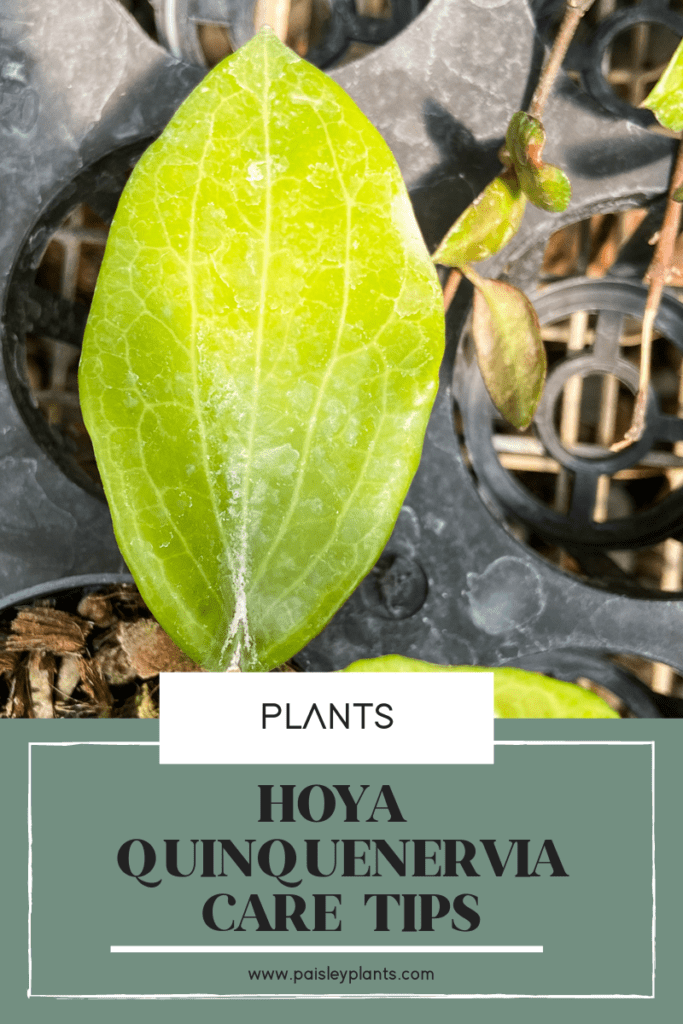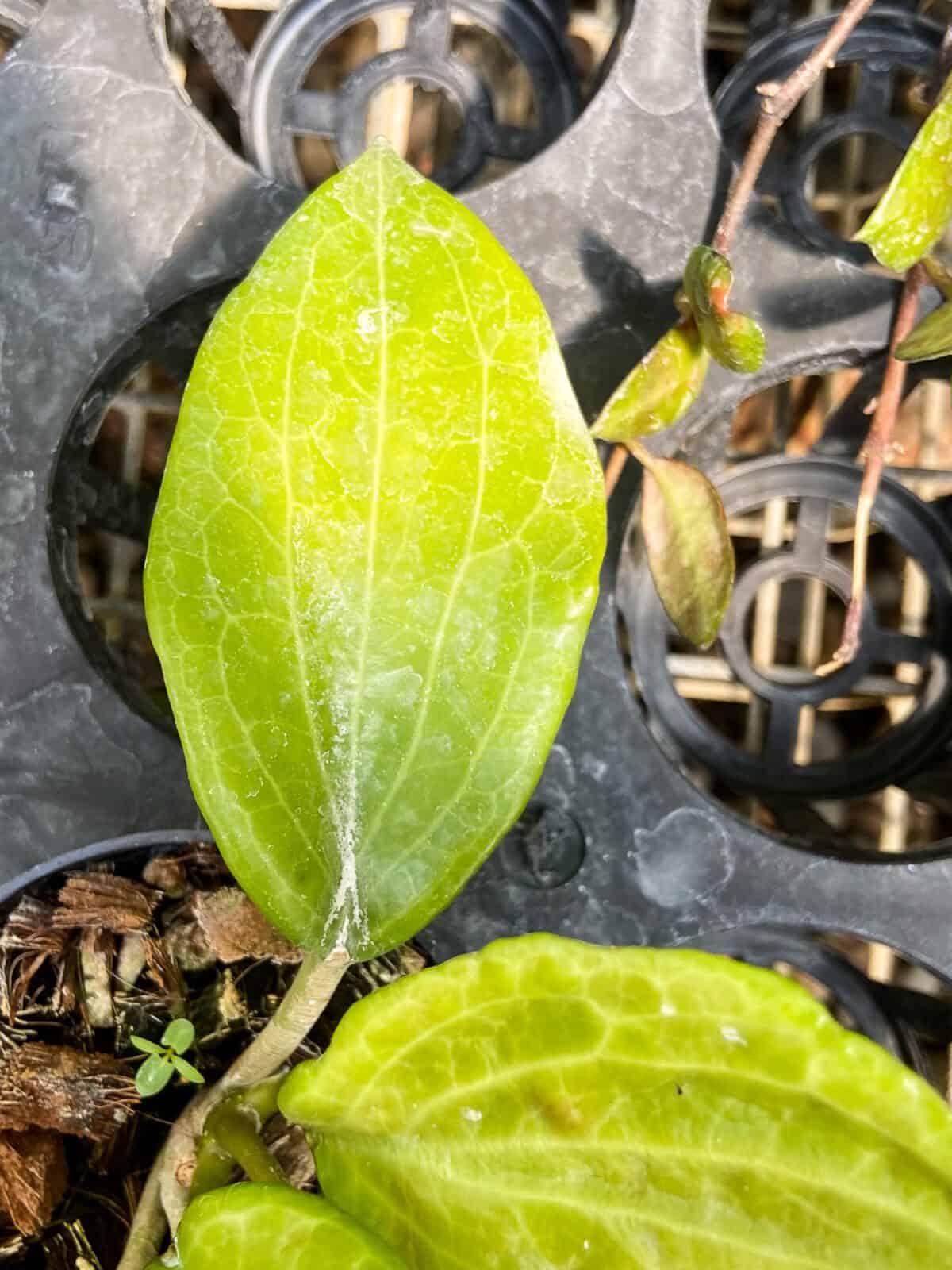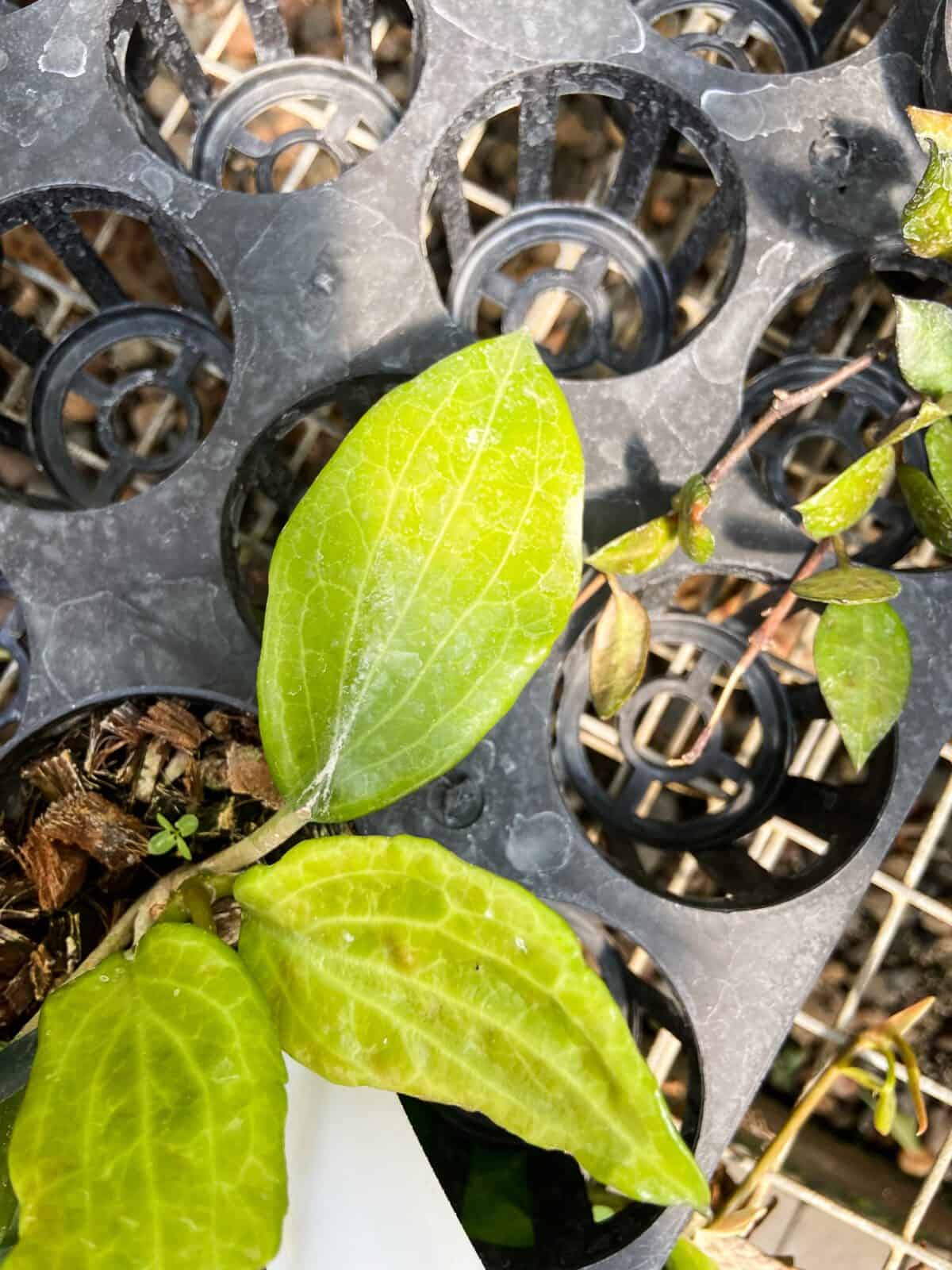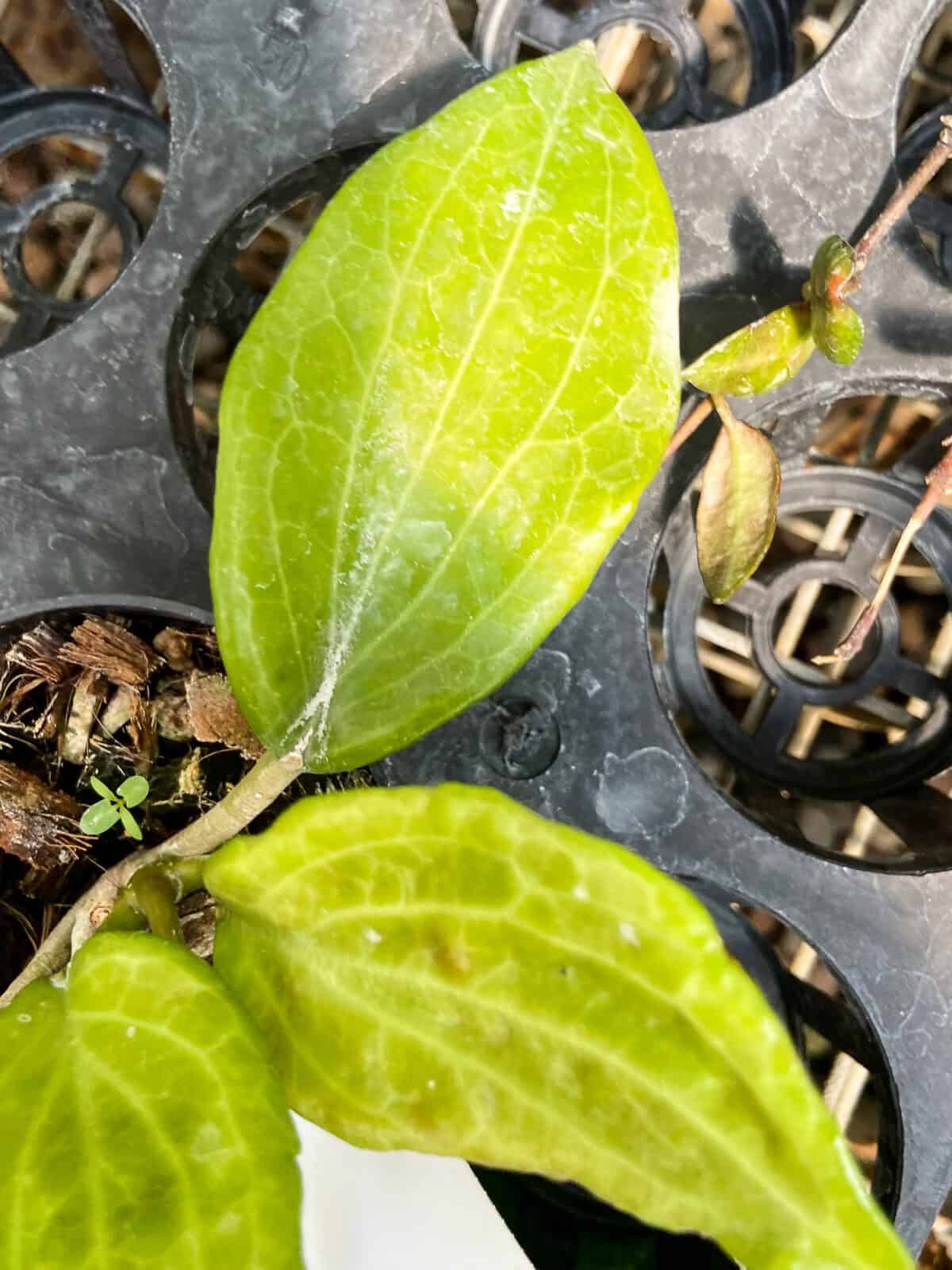Colorful and alluring, the hoya quinquenervia is a quirky variety of the well-known hoya genus. The quinquenervia is very unique in appearance and is pleasantly easy to care for. It is also a prolific bloomer.
There is no need to stress about caring for this plant. Read on for more in-depth information about how to care for your hoya quinquenervia.

Table of Contents
Background
Originally native to the island of Luzon in the Philippines, the Hoya quinquenerva is a very unique and beautiful member of the hoya genus.
The quinquenerva is a succulent type of hoya. Its waxy leaves allow it to retain moisture that keeps the plant fed and will tolerate minimum levels of watering.
Young leaves often have reddish/purple hues and the larger leaves may take on a stronger reddish tone when grown in strong light.
The leaves grow in a variety of colors, ranging from green, purple, and red. The amount of sunlight and the age of the leaves will determine if some hoya quinquenervias are redder than others.
The flowers of the hoya quiquenervias are yellow in color with a pink center, smooth on the outside with delicate hairs and have a white crown. They are star shaped and grow in clusters that have a waxy like appearance.
The flowers have a mildly sweet scent. The flower stalks are called penduncles. Do not cut off these penduncles (flower stalks) after they bloom as the hoyas can rebloom from the same stalk over and over again.
This particular hoya variety can grow rather tall, 4 feet tall and 2 feet wide to be exact. To allow your hoya to reach its maximum height, train it on a moss pole so that it will stretch out and grow upward.
Just like many other types of hoya, the quinquenervia is an epiphytic plant; meaning that they naturally grow on trees, rather than in the soil. This allows air to pass through its root system.
The hoya quinquenervia is non-toxic to both humans and animals. You can own a hoya plant safely with small children and pets in the home.
Hoya Quinquenervia Care

Sun & Light
Place your hoya in a location that receives bright, indirect light. However, the quinquenervia is capable of withstanding a small amount of direct sunlight, preferably morning sun. Exposure to light can cause the hoya’s foliage to turn a more reddish hue.
The hoya leaves will have a redder color if it is exposed to light direct morning sun. If you have a hoya that isn’t blooming, you should move the plant to a location with better lighting to help the blooming process.
If you live in an area without good light, you can aid your hoya’s growth with grow lights. You can use high output t-5 fixtures for this purpose. The tubes use 54 watts each and can be hung over the plants or mounted on a wall. These can be purchased online with vendors such as Amazon.
Soil Type
Like most hoyas, the quinquenervia is an epiphytic plant. In its natural habitat, the hoya takes up residence by growing on top of other plants. This allows the hoya’s root system to have maximum aeration. Hoyas do not like clogged soil!
There are many potting mixtures on the market that are tailored to epiphytic plants. These mixes contain chunky materials such as perlite, bark, or pumice that allow for airflow, along with moisture-retaining material such as peat moss to keep the roots nourished.
Water

The waxy leaves of the hoya plant are succulent leaves which retain moisture. As a result, it is not necessary to maintain a consistently moist soil for this plant.
Remember, the thicker the leaves of your hoya, the less frequently it needs to be watered. Also, misting only raises the humidity level for the plant until the water evaporates, so isn’t very useful for hoyas.
A good measure for properly watering your hoya is to wait until the soil is nearly dry before rehydrating your plant. To avoid overwatering your hoya, be sure the leaves are slightly soft and that the soil is completely dry before watering.
Use room temperature water that has been allowed to sit for a day or two prior to watering your plants. Cold water can stress these plants because they are tropical in nature. Also, letting the water sit for a day or two will help the chemicals in the water dissipate.
Watering at the beginning of the day will allow moisture to be available during the daylight hours and will also ensure that the leaves are not wet and the plant is dry at night.
Water the soil evenly and be sure the water drains out from the container so it does not build up in the bottom of the container. This can cause the soil to become too wet and cause root rot. Proper drainage is also key to maintaining a healthy plant.
Fertilizing
While fertilizing your plant is not a necessity, it is always helpful to help encourage vigorous growth in your plant. Apply a balanced houseplant fertilizer to your hoya once a month during the growing season (spring and summer).
A good dilution rate is one teaspoon of fertilizer to every gallon of water, but be sure to carefully follow the fertilizer directions, so you don’t risk over-fertilizing your plant.
Temperature & Humidity
Being native to Southeast Asia, the hoya quinquenervia is partial to warmer air temperatures. Ideally, your household should be within the 60° to 75° F range, which is more than attainable for the average household. Any added humidity is a plus for this type of plant, however.
Your hoya will grow comfortably in regular household humidity as long as there is good air ventilation in the room. Avoid very high levels of humidity (60% or greater) as this can increase the susceptibility of pests.
Pruning & Maintenance

Pruning your hoya not only helps maintain its appearance, but it is also an effective way to encourage fuller, bushier growth. Using the cuttings you remove from your plant will also give you multiple houseplants for free! (See below for information on this).
Always prune any dead or damaged leaves when you notice them. These leaves are a hindrance to the overall growth rate of your plant.
As mentioned above, do not remove any parts of the plant when the flower bloom is done blooming. Flowers will grow again on these penduncles (flower stalks) during the next blooming cycle your plant has.
Also, don’t change the location of your hoya after it begins to bud as the buds may drop due to the stress of the plant being relocated.
Choosing a Container & Repotting
When selecting a container for your epiphytic hoya plant, it is important to select a planter that has multiple drainage holes at the bottom. Drainage holes give unused water a place to escape from the pot. Its purpose is to prevent the roots from becoming oversaturated.
Since most hoyas grow in the wild as ephiphytes, they don’t have deep roots. This means they do not need to be planted in a deep pot.
You can expect to repot your hoya every 1 to 2 years, or sooner if you notice roots beginning to grow out from the drainage holes. Every potting mix will breakdown over time and lose its ability to hold moisture.
Other signs your hoya needs to be repotted are if the plant is pale, wobbly and has stopped growing. If the water just runs through to the bottom of the pot without making the soil wet, then it is also ready to repot.
When repotting your hoya plant, be sure to size up gradually. Select a pot that is only 1-2 inches larger than the previous pot. Sizing up too drastically can increase the odds of transplant shock to your plant.
Be sure to wash off as much of the old potting soil as possible to give your plant a fresh start in the new soil.
How to Propagate a Hoya Quinquenervia
The best way to propagate a hoya quinquenervia is via leaf cuttings. Propagation from cuttings is a very easy, yet rewarding process.
This can be done either directly into soil using rooting hormone powder or liquid or by first placing the cuttings into water to grow roots. After the roots grow in water, you can place the cuttings in soil to grow.
To grow in soil, follow these steps:
- Take a healthy leaf cutting from your plant. The leaf needs to have at least one prominent node on it, but can have as many as two to six nodes per cutting.
- Place the cut-end of your leaf cutting into rooting hormone powder. This hormone rooting powder can be purchased at a garden center or online. It also comes in a liquid form. While this step is not mandatory, it should be noted that it significantly increases the likelihood that your propagation will be successful.
- After putting the rooting hormone powder on the base of the stem, place it down into a pot filled with potting soil. Be sure to trim the lower leaves.
- Water the soil. Roots should develop within a couple of weeks on this new planting.
To root in water:
- Put the cutting into a jar filled with water and place it in a warm location with bright light. Keep the water level to the rim of the jar by replacing it each week in order to reduce the chance of bacteria prematurely rotting your leaf cutting.
- It takes roughly one month to be able to see roots forming from the bottom of the cutting. Wait until the roots are at least one inch in length before transplanting into soil.
- Fill a pot with pre-moistened soil and transplant the leaf cutting. To help avoid the risk of transplant shock, keep the soil consistently moist for the next two weeks. You may also add some hormone rooting powder to the cutting prior to placing it in the soil to aid in rapid growth.
- You will know that the propagation was a success when you notice new growth forming from the tops of the leaves.
Common Pests
Pests commonly attack hoyas that live in overtly humid conditions. If you live in a naturally humid environment, you need to be extra vigilant to detect any signs of pests.
Household pests including aphids, spider mites, and mealybugs like to latch onto the foliage of your hoyas and suck the nutrients right out of their fleshy leaves. If you don’t see the pests themselves, you will definitely see the peppered discoloration they leave behind.
Even though pests are a major nuisance to any plant owner, they can easily be remedied with simple solutions. One of the most popular household methods involves combining one tablespoon of dish soap with a gallon of water.
Spray your plants with this mixture and wipe down the foliage; it may take a few applications of this solution in order to fully eliminate the pests.
Other gardeners swear by using neem oil to control their pest problem. Neem oil is a natural pesticide that can be used in the same way as the dish soap mixture. Just like the previous solution, you will need to spray your plants in multiple rounds to ensure that your pests are exterminated.
Neem oil can be purchased at a garden center or online. Follow the instructions on the container to use this product.
Common Diseases
One of the most common diseases associated with epiphytic houseplants such as the hoya quinquenervia is root rot. Root rot is a terrible fungal disease that results from trapped moisture developing into harmful bacteria.
Too much water and not enough drainage are the leading causes of root rot. Signs that your plant may be suffering from root rot include dying, discolored foliage and rapidly yellowing leaves.
Root rot cannot be reversed, but it can be cured if you act quickly. Follow these steps in order to remedy root rot:
- Remove the plant from its pot and inspect its root system. Healthy roots are firm and off-white. Rotted roots are mushy and black in color.
- If the entire root system is already mushy, it is too late to save the plant. However, if some healthy, white, firm roots exist, you can keep those and cut away the rotted roots.
- Rinse off any of the soil remaining on the root structure and throw away the old soil.
- Place new soil into a pot that is sterilized and has plenty of drainage holes. Repot the plant into the new soil.
- Keep the soil only lightly moist for the first couple weeks to eliminate the risk of shock. It is normal for a plant to appear wilted and thirsty after repotting.
- Refrain from watering until about a week after you have repotted this plant to allow any roots damaged during repotting to heal.
Where to Buy
- Local Nursery
- Etsy
FAQ
First, immediately quarantine your plant from any others that are nearby. That is powdery mildew, which is a very contagious fungus that appears on hoyas that are exposed to too much moisture and humidity. Secondly, prune your plant and cut off any leaves that have powder on them and wrap them in plastic before tossing them in the trash.
When caught and controlled early, powdery mildew can swiftly be controlled through quarantine, pruning, and fungicide. If your plant has been completely overtaken by powdery mildew, then you may have to start anew.
You can prevent powdery mildew by keeping the humidity at a low level in your home and minimizing any unnecessary moisture. Water your plant as close to the base as possible, avoiding getting the foliage wet.
In Conclusion
The hoya quinquenervia is a gorgeous houseplant that is bound to turn the heads of all your houseguests. When in bloom, this beautiful plant is a lovely way to enhance the beauty of your houseplant collection.
Its blend of colors and glossy leaves make for a beautiful addition to any home.
Check these other hoya houseplant posts!
